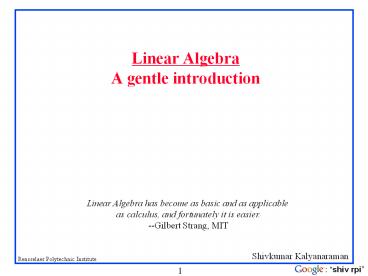Linear Algebra A gentle introduction - PowerPoint PPT Presentation
1 / 29
Title:
Linear Algebra A gentle introduction
Description:
Linear Algebra A gentle introduction Linear Algebra has become as basic and as applicable as calculus, and fortunately it is easier.--Gilbert Strang, MIT – PowerPoint PPT presentation
Number of Views:1198
Avg rating:3.0/5.0
Title: Linear Algebra A gentle introduction
1
Linear Algebra A gentle introduction
Linear Algebra has become as basic and as
applicable as calculus, and fortunately it is
easier. --Gilbert Strang, MIT
2
What is a Vector ?
- Think of a vector as a directed line segment in
N-dimensions! (has length and direction) - Basic idea convert geometry in higher dimensions
into algebra! - Once you define a nice basis along each
dimension x-, y-, z-axis - Vector becomes a 1 x N matrix!
- v a b cT
- Geometry starts to become linear algebra on
vectors like v!
y
v
x
3
Vector Addition AB
AB
A
AB C (use the head-to-tail method to combine
vectors)
B
C
B
A
4
Scalar Product av
av
v
Change only the length (scaling), but keep
direction fixed. Sneak peek matrix operation
(Av) can change length, direction and also
dimensionality!
5
Vectors Dot Product
Think of the dot product as a matrix
multiplication
The magnitude is the dot product of a vector with
itself
The dot product is also related to the angle
between the two vectors
6
Inner (dot) Product v.w or wTv
The inner product is a SCALAR!
If vectors v, w are columns, then dot product
is wTv
7
Bases Orthonormal Bases
- Basis (or axes) frame of reference
vs
Basis a space is totally defined by a set of
vectors any point is a linear combination of
the basis Ortho-Normal orthogonal
normal Sneak peek Orthogonal dot product is
zero Normal magnitude is one
8
What is a Matrix?
- A matrix is a set of elements, organized into
rows and columns
rows
columns
9
Basic Matrix Operations
- Addition, Subtraction, Multiplication creating
new matrices (or functions)
Just add elements
Just subtract elements
Multiply each row by each column
10
Matrix Times Matrix
11
Multiplication
- Is AB BA? Maybe, but maybe not!
- Matrix multiplication AB apply transformation B
first, and then again transform using A! - Heads up multiplication is NOT commutative!
- Note If A and B both represent either pure
rotation or scaling they can be interchanged
(i.e. AB BA)
12
Matrix operating on vectors
- Matrix is like a function that transforms the
vectors on a plane - Matrix operating on a general point gt transforms
x- and y-components - System of linear equations matrix is just the
bunch of coeffs ! - x ax by
- y cx dy
13
Direction Vector Dot Matrix
14
Matrices Scaling, Rotation, Identity
- Pure scaling, no rotation gt diagonal matrix
(note x-, y-axes could be scaled differently!) - Pure rotation, no stretching gt orthogonal
matrix O - Identity (do nothing) matrix unit scaling, no
rotation!
r1 0 0 r2
0,1T
0,r2T
scaling
r1,0T
1,0T
-sin?, cos?T
0,1T
cos?, sin?T
rotation
?
1,0T
15
Scaling
P
P
a.k.a dilation (r gt1), contraction (r lt1)
16
Rotation
P
17
2D Translation
P
t
P
18
Inverse of a Matrix
- Identity matrix AI A
- Inverse exists only for square matrices that are
non-singular - Maps N-d space to another N-d space bijectively
- Some matrices have an inverse, such thatAA-1
I - Inversion is tricky(ABC)-1 C-1B-1A-1
- Derived from non-commutativity property
19
Determinant of a Matrix
- Used for inversion
- If det(A) 0, then A has no inverse
http//www.euclideanspace.com/maths/algebra/matrix
/functions/inverse/threeD/index.htm
20
Projection Using Inner Products (I)
p a (aTx) a aTa 1
21
Homogeneous Coordinates
- Represent coordinates as (x,y,h)
- Actual coordinates drawn will be (x/h,y/h)
22
Homogeneous Coordinates
- The transformation matrices become 3x3 matrices,
and we have a translation matrix!
1 0 tx 0 1 ty 0 0 1
x y 1
x y 1
New point Transformation
Original point
Exercise Try composite translation.
23
Homogeneous Transformations
24
Order of Transformations
- Note that matrix on the right is the first
applied - Mathematically, the following are equivalent
- p ABCp A(B(Cp))
- Note many references use column matrices to
represent points. In terms of column matrices - pT pTCTBTAT
T
R
M
25
Rotation About a Fixed Point other than the Origin
- Move fixed point to origin
- Rotate
- Move fixed point back
- M T(pf) R(q) T(-pf)
26
Vectors Cross Product
- The cross product of vectors A and B is a vector
C which is perpendicular to A and B - The magnitude of C is proportional to the sin of
the angle between A and B - The direction of C follows the right hand rule if
we are working in a right-handed coordinate system
AB
B
A
27
MAGNITUDE OF THE CROSS PRODUCT
28
DIRECTION OF THE CROSS PRODUCT
- The right hand rule determines the direction of
the cross product
29
For more details
- Prof. Gilbert Strangs course videos
- http//ocw.mit.edu/OcwWeb/Mathematics/18-06Spring-
2005/VideoLectures/index.htm - Esp. the lectures on eigenvalues/eigenvectors,
singular value decomposition applications of
both. (second half of course) - Online Linear Algebra Tutorials
- http//tutorial.math.lamar.edu/AllBrowsers/2318/23
18.asp























![Solve Simultaneous Equations One Linear, one quadratic [Circle] PowerPoint PPT Presentation](https://s3.amazonaws.com/images.powershow.com/5861858.th0.jpg?_=20200807031)







